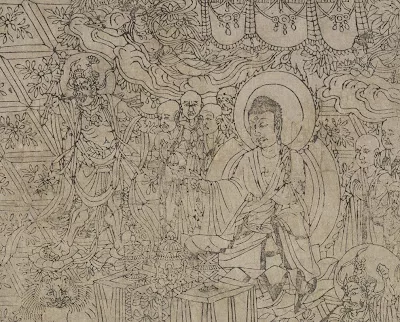IDP Intern: Feichi Gao (Northumbria University)

I’m currently a student at Northumbria University studying MA Preventive Conservation. My five-week internship with IDP started on Monday 16th February following some great anticipation and slight anxiety. Now as my internship is coming to an end I can truly conclude that this has been a priceless experience and I feel so lucky to have been able to get involved.

The project I’ve been working on — collection care and digitisation of Tangut material — is very interesting and relevant to my background. This collection includes over 6000 paper fragments that Sir Aurel Stein excavated from Kharakhoto at the beginning of the 20th century. The condition and formats of items I’ve been working on are in great variety: some of them are manuscripts with beautiful handwriting, others are from printed books, some are in very good condition like they were made yesterday, others may have lost all the strength and are turning to dust. These material remains all belong to an ancient Central Asian ethnic group called the Tangut (also called Xixia or Western Xia), who established an empire between China and Tibet in the 11th century. This mysterious empire is of great interest and significance to scholars studying Central Asia, the Silk Road, the Chinese Song Dynasty, etc. However, I first learned about the Xixia from Louis Cha Leung-yung’s novels of ‘martial arts and chivalry’ (武侠) when I was a child, and to me this Tangut empire is more like a romantic fantasy than real history. Bearing this in mind, one can easily understand how wonderful this project is to me, not just because it benefits my professional life, but also because of my personal enjoyment.

My daily work on this project almost includes all the major parts of IDP’s workflow. I was showed how these materials are stored in the British Library basement with various storage methods in a fully controlled and monitored environment. Then I started my work by putting eight phase boxes of Tangut material in sequence according to their pressmarks. After that I took two boxes of Tangut fragments to the British Library Centre for Conservation (BLCC) and encapsulated them in new clear Melinex sheets. The method of encapsulation is quite simple but requires caution and steady hands. First I took the fragments out from old polyester sleeves and put them between two 40cm x 40cm Melinex sheets, then I welded several spots around each item to provide support and prevent them from sliding inside, and finally I sealed each edge of the Melinex sheets using a specially designed polyester welder. After rehousing, the paper fragments are better presented and protected and will be ready for digitisation and reader requests. I also spent a lot of time in the IDP studio where the Tangut material is digitised so high quality images will be freely available for scholars all around the world. Another major task of my work is to measure the length and width of each fragment and add the information to the IDP database, which is the destination of all the digital images and other important information.
Finally I want to thank all the IDP staff, paper conservator Wingyui Wong, preventive conservator Karen Bradford, and all the amazing people I’ve met in the Library for their help and guidance.







If you have feedback or ideas about this post, contact us, sign in or register an account to leave a comment below